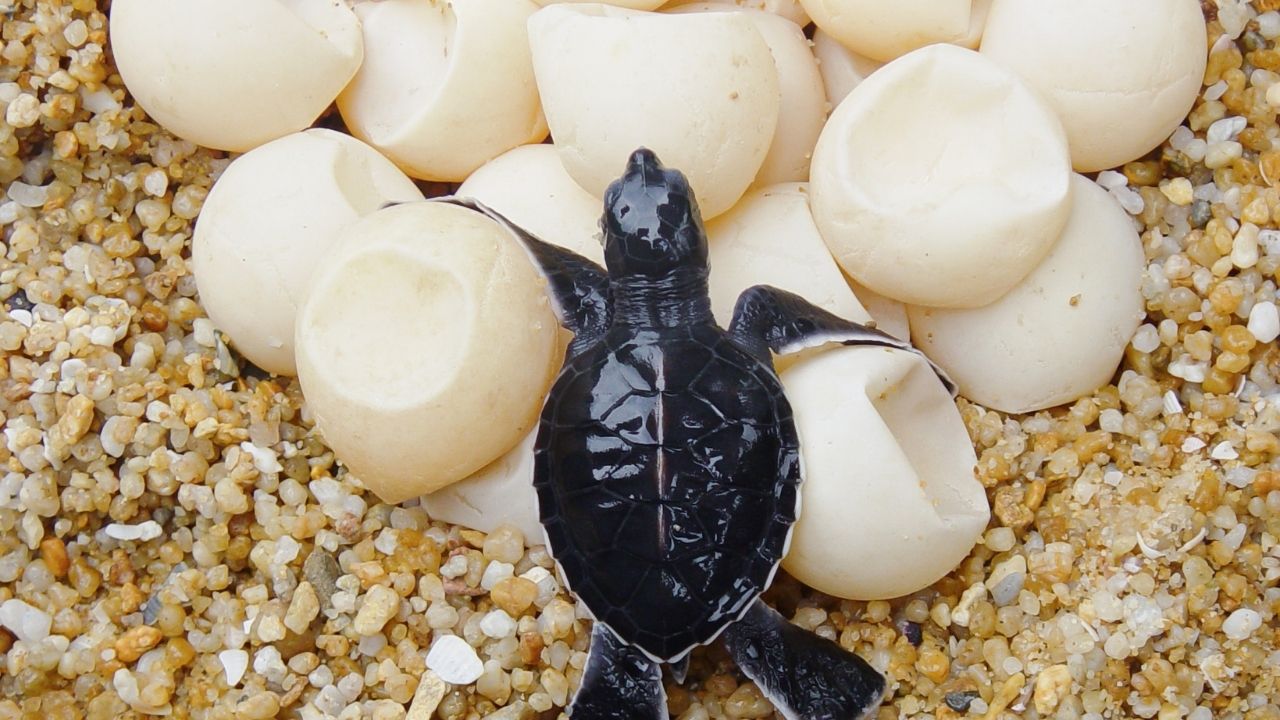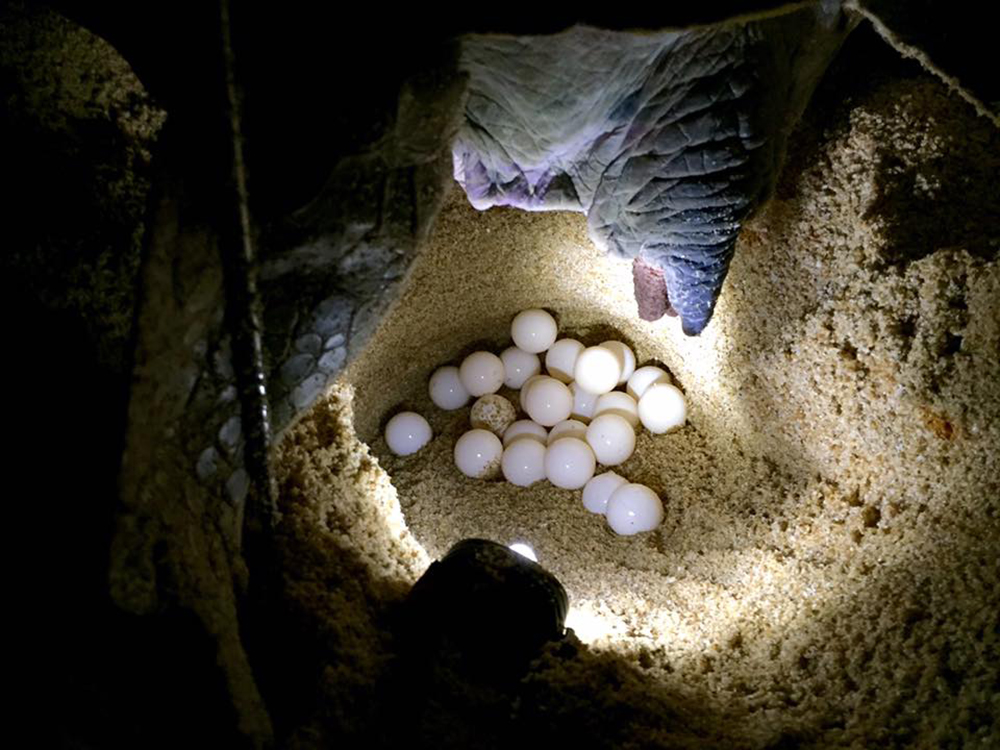Turtles lay an average of 100 eggs, but some species can lay up to 200 eggs. Turtles are fascinating creatures that have captivated humans for centuries with their unique characteristics and behaviors.
One of the most remarkable aspects of turtle reproduction is their ability to lay eggs. As one might expect, the number of eggs turtles lay can vary depending on the species. On average, turtles lay around 100 eggs per nest, but certain species can lay as many as 200 eggs.
This large number of eggs is necessary due to the high mortality rate among turtle hatchlings. Throughout this article, we will explore the fascinating world of turtle egg laying, discussing the factors influencing the number of eggs, and the remarkable ways turtles ensure the survival of their offspring.

Credit: theturtlehub.com
Understanding Turtle Reproduction
Importance Of Understanding Turtle Reproduction
Turtles are fascinating creatures, known for their slow pace and ancient existence. One of the most crucial aspects of understanding turtles is their reproduction. By delving into the intricacies of how turtles reproduce, we gain valuable insights into the survival, conservation, and management of these gentle reptiles.
Brief Introduction To Turtle Reproduction
Turtle reproduction is a complex process that varies among different species and is influenced by various factors such as habitat conditions, temperature, and genetics. Let’s explore the key points of turtle reproduction:
- Sexual dimorphism: Many turtle species exhibit sexual dimorphism, wherein males and females have distinct physical characteristics, such as size, coloration, or tail length. This distinction aids in identifying the sex of turtles.
- Mating behavior: Turtles engage in unique mating rituals. While some species perform elaborate courtship displays, others have fierce competition among males for access to females. Understanding these behaviors can provide valuable insights into the species’ social dynamics and breeding patterns.
- Nesting habits: Female turtles travel long distances to find suitable nesting sites, often returning to the same area year after year. Learning about their nesting habits helps us identify critical areas for conservation and the implementation of protective measures.
- Nesting season: Many turtle species have specific nesting seasons, determined by environmental factors like temperature. By understanding the nesting season, researchers and conservationists can determine when to conduct surveys and implement measures to protect the eggs and potential hatchlings.
- Egg development: Turtle eggs undergo fascinating processes during incubation. Factors such as temperature determine the gender of the hatchlings. The duration of incubation can vary significantly among different species, highlighting the importance of understanding the specific requirements for successful breeding.
- Hatchling survival: The journey for turtle hatchlings is perilous, as they must navigate various threats, including predators and obstacles, to reach the safety of the water. Understanding their vulnerabilities and challenges can aid in conservation efforts to improve their survival rates.
- Global significance: Turtles play a vital role in maintaining ecosystems’ health, functioning as both predators and prey. Additionally, they serve as indicators of habitat quality and can help scientists assess the overall health of aquatic environments.
Through a deeper comprehension of turtle reproduction, we not only unlock the secrets to their survival but also contribute to the conservation and preservation of these ancient creatures. By implementing measures to protect nesting grounds, monitor population trends, and educate communities, we can ensure a more sustainable future for these remarkable reptiles.
So, let’s dive into the enchanting world of turtle reproduction and unveil its mysteries together.
The Egg-Laying Process
Turtle Mating Habits And Behaviors
Turtles are fascinating creatures that display unique mating habits and behaviors. In order to appreciate the egg-laying process, it’s important to first understand the intricacies of turtle mating. When it comes to reproduction, turtles have specific rituals and behaviors that ensure successful fertilization.
Some key points about turtle mating habits and behaviors include:
- Courtship rituals: Before mating, turtles engage in courtship rituals that vary from species to species. These rituals often involve head bobbing, shell strokes, and gentle biting. These behaviors are crucial in establishing the readiness and compatibility of potential mates.
- Male competition: In some turtle species, males compete for the attention and favor of a female. This competition can involve aggressive behaviors such as pushing and shoving to establish dominance. The male that displays the most strength and persistence is often chosen by the female as her mate.
- Intromittent organs: Male turtles possess specific reproductive organs known as intromittent organs, which are used to transfer sperm to the female during mating. These organs can vary in shape and size depending on the species, but they all serve the same purpose of delivering the sperm for fertilization.
How many eggs do turtles lay? A closer look at egg clutches
Now that we’ve explored the fascinating mating habits and behaviors of turtles, let’s delve deeper into the topic of how many eggs turtles lay. The number of eggs laid by turtles can vary depending on several factors, including:
- Species: Different turtle species have varying egg-laying habits. Some species lay only a few eggs per clutch, while others can lay dozens. For example, a loggerhead turtle can lay around 100 eggs per clutch, whereas a box turtle may lay only 1-7 eggs per clutch.
- Reproductive cycle: Turtles typically have a reproductive cycle that includes multiple clutches of eggs throughout the breeding season. The number of clutches laid by a turtle during a season can impact the total number of eggs laid.
- Environmental conditions: Environmental factors such as temperature and food availability can influence the number of eggs turtles lay. Adequate food resources and optimal temperatures for egg development contribute to higher egg production.
- Female size and age: Larger and older females tend to lay more eggs compared to younger and smaller females. This is because larger females have more energy reserves to allocate towards egg production.
Understanding these factors gives us a clearer picture of how many eggs turtles lay. By studying the unique mating behaviors and considering various influences on egg production, we can gain a deeper appreciation for the intriguing world of turtle reproduction.
Where Do Turtles Lay Their Eggs?
Turtles are fascinating creatures, known for their slow and steady lifestyle. But did you know that turtles also lay eggs? If you’re curious about the number of eggs turtles lay and where they choose to nest, you’ve come to the right place.
In this blog post, we’ll dive into the intriguing world of turtle nesting habits. Join us as we explore the selection of nesting sites by turtles and the ideal conditions for nesting.
Selection Of Nesting Sites By Turtles
Turtles are meticulous when it comes to choosing the perfect location to lay their eggs. They invest time and effort into finding the ideal nesting site, ensuring the survival of their offspring. Here are some key points about the selection of nesting sites by turtles:
- Turtles typically seek sandy or soft soil areas for their nests, which allow them to easily dig and bury their eggs.
- The proximity to water is crucial for turtles, as they need a suitable environment for their eggs to incubate properly.
- Some species of turtles have specific preferences for nesting, such as laying eggs on the same beach where they were born. This behavior is known as natal homing.
- Factors like temperature, moisture levels, vegetation cover, and accessibility also influence the selection of nesting sites by turtles.
The Ideal Conditions For Nesting
Creating the perfect conditions for nesting is essential for the survival of a turtle’s eggs. Here are a few key points about the ideal conditions for nesting:
- Temperature plays a vital role in egg development. The temperature at which the eggs are incubated determines the sex of the hatchlings in some turtle species.
- Moisture levels are crucial, as too much or too little moisture can affect the viability of the eggs. Adequate moisture provides the necessary humidity for the eggs to develop properly.
- Vegetation cover and natural barriers are important to protect the nesting site from predators and human disturbances.
- An accessible nesting site allows turtles to navigate easily and safely from the water to the nesting area.
- It’s worth noting that different turtle species have unique nesting requirements, which are adapted to their specific habitats and evolutionary history.
Understanding the selection of nesting sites by turtles and the ideal conditions for nesting gives us valuable insight into the lives of these amazing creatures. Stay tuned for more fascinating facts about turtles and their captivating behaviors.
Incubation And Hatching
Turtles are fascinating creatures that have a unique reproductive process. One intriguing aspect of their life cycle is the incubation and hatching of their eggs. Understanding this process can shed light on the challenges faced by baby turtles as they make their way into the world.
In this section, we will delve into the turtle egg incubation period, the influence of temperature on gender determination, and the hatching process itself.
Turtle Egg Incubation Period
- The incubation period for turtle eggs can vary depending on the species.
- It typically ranges from 45 to 90 days.
- The eggs are laid in nests on land where they are exposed to temperature fluctuations.
- The duration of incubation is influenced by various factors, including temperature and humidity levels.
Temperature Influence On Gender Determination
- The temperature at which the eggs are incubated plays a crucial role in determining the gender of the hatchlings.
- For most turtle species, lower temperatures result in males, while higher temperatures result in females.
- This phenomenon, known as temperature-dependent sex determination, is significant for the population dynamics and conservation of turtle species.
Hatching Process And Challenges Faced By Turtles
- The hatching process begins when the embryo breaks the shell using an egg tooth.
- Hatchlings often face challenges such as predation and harsh environmental conditions.
- They must navigate their way to the water, which can be a perilous journey.
- Changes in coastal landscapes and increased human activities pose additional threats to their survival.
Understanding the incubation and hatching process of turtle eggs provides valuable insights into the challenges faced by these remarkable creatures. By studying and conserving their nesting habitats, we play a crucial role in ensuring the survival of turtle populations for future generations.
Protecting Turtle Eggs
Turtle eggs, a marvel of nature, are an integral part of the turtle life cycle. How many eggs do turtles lay? It’s a fascinating question that brings us closer to understanding these remarkable creatures. But beyond the numbers lies the importance of protecting these eggs.
###threats and challenges to turtle eggs: turtles face numerous threats and challenges when it comes to their eggs. Here are some key points to consider:
- Predators: Many predators, such as raccoons, foxes, and birds, have developed a taste for turtle eggs. These predators can quickly deplete turtle populations if left unchecked.
- Habitat loss: The destruction and degradation of nesting habitats due to human activities, including coastal development and climate change, pose a significant threat to the survival of turtle eggs.
- Climate change: Rising temperatures and changing weather patterns can impact the incubation process, leading to abnormalities or reduced hatchling success.
- Beach disturbance: Human activities on nesting beaches, such as beach cleaning, vehicle traffic, and tourist activities, can disturb and damage turtle nests, resulting in reduced egg survival rates. ###conservation efforts to protect turtle eggs: thankfully, numerous conservation efforts are underway to protect turtle eggs and ensure the survival of these incredible creatures. Consider the following:
- Nest protection: Conservationists implement measures to protect nests, such as erecting wire cages or using screen mesh, to prevent predators from accessing the eggs.
- Nest relocation: In some cases, when nests are at risk due to human activity or extreme weather events, conservationists carefully relocate them to safer locations.
- Education and awareness: By raising awareness about the importance of protecting turtle eggs, conservation organizations help foster a sense of responsibility within local communities and tourists to minimize disturbances and support conservation efforts.
- Regulation and enforcement: Governments and conservation agencies are enacting and enforcing regulations to protect nesting beaches and enforce sustainable practices to minimize human impact.
- Research and monitoring: Continuous research and monitoring of turtle populations and nesting habits provide crucial data that inform conservation strategies and enable targeted efforts to protect eggs. It’s clear that protecting turtle eggs is of utmost importance to preserve these majestic creatures. By addressing the threats they face and implementing effective conservation measures, we can ensure the continuation of their remarkable life cycle for generations to come.
Frequently Asked Questions Of How Many Eggs Do Turtles Lay
How Many Eggs Does A Turtle Lay At Once?
Turtles can lay anywhere from a few eggs to over 100 in a single clutch, depending on the species. For example, sea turtles can lay around 100 eggs, while terrestrial turtles may lay a smaller number, typically around 5-30 eggs per clutch.
How Often Do Turtles Lay Eggs?
Turtles lay eggs once or twice a year, typically during the nesting season. The nesting season varies among species and is influenced by factors such as temperature and habitat. Some turtles may lay eggs every year, while others may wait several years between nesting seasons.
Why Do Turtles Lay Eggs In The Sand?
Turtles lay eggs in the sand because it provides a safe and protected environment for the eggs. The sand cushions the eggs, helps to maintain the right temperature, and also offers camouflage from potential predators. This nesting behavior allows the eggs to develop properly until they are ready to hatch.
How Long Does It Take For Turtle Eggs To Hatch?
The time it takes for turtle eggs to hatch varies depending on the species and environmental conditions. Generally, it can take anywhere from 45 to 90 days for the eggs to develop and hatch. The temperature of the nesting site plays a crucial role in determining the duration of the incubation period.
Do All Turtle Eggs Hatch Successfully?
Not all turtle eggs hatch successfully. Factors such as predators, extreme temperatures, and habitat disturbances can affect the survival rate of turtle eggs. Additionally, some turtle species have a naturally low hatch success rate due to biological factors. However, turtles have evolved to produce a large number of eggs to compensate for low hatchling survival.
Conclusion
Understanding how many eggs turtles lay is crucial for their conservation and population management. By studying their nesting behavior, scientists and researchers can gather valuable data to protect and preserve turtle populations worldwide. It is fascinating to learn that the number of eggs turtles lay can vary greatly depending on their species, size, and environmental factors.
From sea turtles laying hundreds of eggs in a single clutch to freshwater turtles laying smaller numbers, each species contributes to the unique and delicate balance of our ecosystems. Furthermore, threats such as habitat loss, pollution, and climate change continue to impact turtle populations and their reproduction.
Therefore, it is essential for us to educate ourselves and take necessary steps to protect these fascinating creatures and their nests. By doing so, we can ensure the continued survival and well-being of turtles for future generations.
Recent Posts
Turtles headbutt black things due to their instinctual response to threats or territorial disputes. When turtles encounter black objects, they may perceive them as intruders or competitors, leading...
To fix a hole in a turtle shell, clean the wound thoroughly and apply adhesive or a patch specifically designed for shell repairs. Then monitor the turtle for any signs of infection or further...

